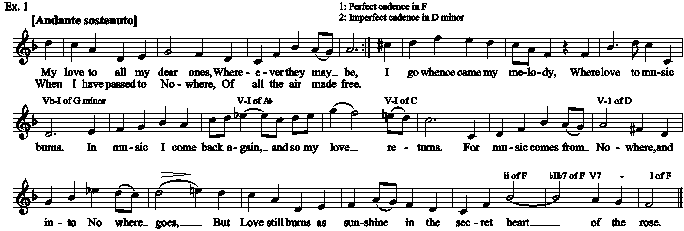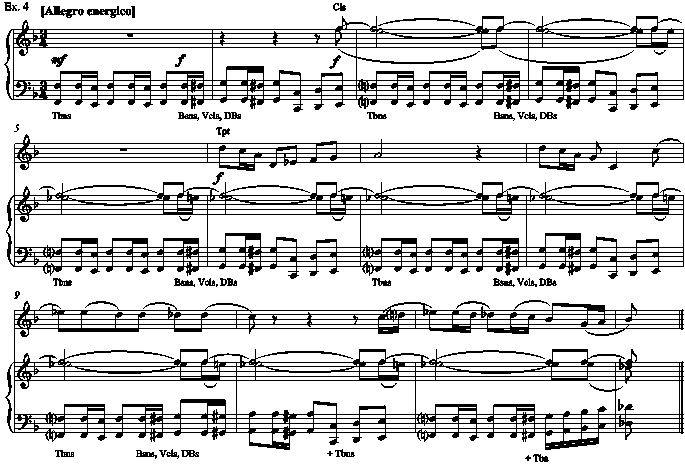Rutland Boughton:
Reunion Variations for Orchestra
It is axiomatic to
assert that a composer lives on in his
music, but in the Reunion Variations
for Orchestra Rutland Boughton added
a characteristic twist to the old adage
when he finished the work with a ‘Song-ending’
which sets a poem of his own invention
and then expressly asked for the work
not to be performed until after his
death. See Ex. 1 for the theme as it
appears at the end. The last of the
three verses of the poem ends thus:
So pour your songs love-hearted
Throughout the stelline blue.
When you on earth make music
I shall be there with you.
My love to all my dear ones,
Wherever they may be;
Or on the earth yet singing,
Or in the air with me.
In a performance which
I was privileged to conduct last November
in Hitchin Town Hall, the soprano soloist,
Sally Silver, sang this from the gallery
above and behind the audience so that
the song seemed to be sung by a disembodied
spirit. The whole song had a strange,
powerful and entrancing effect upon
the audience.
There is another ending
to the Variations. Ever the practical
composer, Boughton composed a version
for orchestra alone, in case a singer
were not available. In this version
(A), the theme appears at the beginning
and there is an orchestral coda. Since
this version had never been performed,
I determined to give it its world première
at our concert – and to give the ‘Song-ending’
version (B) its second performance (
- it had been premièred at a
Memorial Concert in Aylesbury in 1967.
Members of the audience were divided
as to the relative merits of the two
versions. It was generally agreed that
the setting of the poem which ended
version B was extraordinarily beautiful
but it was also thought that version
A made a very fine set of purely orchestral
variations that would grace any orchestra’s
programme.
The Variations are
a superb set of pieces, each of them
having a character of its own. Indeed,
Boughton hinted that each was a characterisation
of a member of his family, though did
not say which variation applied to which
person. Musically, they are very individual.
Version A begins Andante sostenuto with
the theme played mainly by the strings
but with some deft wind highlighting
and leads into Variation 1 - the variations
are a continuous set – which is where
version B starts. This variation is
at the same tempo and has the theme
initially in the bass then given to
solo wind before returning to the bass.
The whole set is wonderfully orchestrated
and there are many felicitous touches,
such as the ‘cello solo near the end
of this variation. Now the music picks
up speed and energy and the lower brass,
timpani and harp appear for the first
time. A slight reining in of the speed
enables the convoluted contrapuntal
lines of variation 3 to be heard to
good effect and leads to the first climax
of the piece. Though brief this is a
full-blooded moment, with rich harmonies
and horns to the fore – see Ex. 2. Variation
4, Allegretto leggiero, is a
very pert little number with a prominent
oboe solo - almost certainly a reference
to Joyance - with harp accompaniment.
Its 9/8 rhythm, faster speed and delicate
diatonicism imbue it with an infectious
‘joie de vivre’, capped literally by
some jauntily exuberant piccolo writing..
After a full orchestral climax in which
the last five bars of the theme appear
in augmentation, the music subsides
and leads into Variation 5. This is
a wonderfully bucolic variation, with
solos for all the wind accompanied by
much double stopped pizzicato slapping
of thighs from the strings. The orchestration
is to be treasured – quite virtuosic
– and replete with short rhapsodic passages,
such as that in Ex. 3 for Clarinet.
The next Variation is the reflective
heart of the work. Marked Poco adagio,
it is written for harp and muted strings,
later with cor anglais solo, and has
a sweet nocturnal atmosphere. Gradually
the music becomes more menacing as timpani,
wind and then brass enter. Variation
7 has a solemn grandeur. Initially quiet,
with the theme and lower strings, it
gradually builds to a noble and powerful
climax before a fade and an acceleration
takes us into an energetic Variation
8. In some ways this is the most striking
and original of all the variations.
A clash of clarinets at the start is
superimposed on rollicking horns, trombones
and lower strings – see Ex. 4. Much
use is made of the dactylic rhythm of
Ex. 4 and novel use is made of a pair
of Steel Bars in C and F and syncopated
gong strokes, then piccolo, oboe and
violin glissandi with much drumming.
This certainly is a rumbustious variation.
At the end it dissolves with champagne
corks popping and, after a pause, Variation
9 begins, marked Allegro giojoso.
This is gentle pastoral frolic in 6/8
with prominent flute solos, but not
without interjections from the clarinet,
strings and horn . After a concluding
dominant pedal point, the two versions
then part their ways.
The orchestral coda
is a grand affair. Here the song re-appears
in full on wind and brass with swathing
swirls of violin figuration. After a
noble and majestic climax it winds down
to a sweet end, with two solo violins
underpinned by the final two tonic chords
on the harp. The Song-ending is beautiful.
The entry of the voice is magical, enunciating
clearly what has until now not been
stated openly – this version, you will
remember, starts with Variation 1, not
the Theme. Initially, the accompaniment
is by harp alone, the rest of the orchestra
now quiet, as if in hushed attention.
Gradually, the strings join in from
time to time, but not until verse 2
is reached does the flute enter, trilling,
and then the clarinets. From here on,
the rest of the orchestra enlist in
the singing, eventually leading to the
final and most enticing climax of all,
with busy semiquavers in the upper strings.
The soloist, holding the word ‘bound’
on an E flat, underneath which a magical
shift of keys takes place, then sings
the words quoted at the top of this
article in the keys of G flat and then
A flat, whilst the harp ripples. Finally,
the last quatrain is reached back in
the tonic key and the music winds to
its mystical close with a gentle trombone
chord and harp harmonics to ease the
work into silence.
A wonderful stillness
greeted the end of performance and I
could tell that Boughton’s music and
his poem and Sally Silver’s wonderful
singing and Hitchin Symphony Orchestra’s
playing had all reached the hearts of
the audience. Because we were given
for this concert a substantial grant
by Awards for All, audience and performer
response was sought by means of a questionnaire.
Amongst the many warm comments received,
perhaps the nicest for me was one from
a member of the orchestra who said that
he had enjoyed the term’s rehearsals
for this concert more than any in the
24 years he had been a member. One young
singer in the audience was so entranced
by the poem of the Song-ending that
she immediately wanted to sing it herself.
Warm tributes indeed.
Some 30 members of
the Boughton family attended the concert,
including two sons and a number of grandchildren.
We were delighted that they could hear
this unique piece. In either of its
versions, it is a winner. Version A
would make a splendid item in any orchestral
concert: it is an impressive set of
variations in the tradition of orchestral
sets by Brahms, Elgar and others, whilst
the Version B with Song-ending has such
a marvellous aura. It was Boughton’s
"last attempt to come to terms with
the ‘metaphysical element that [had]
rejoiced and confounded [him] throughout
life’ " [Michael Hurd: "Rutland Boughton
and the Glastonbury Festivals", Clarendon
Press, 1993]. Above all, the piece should
be in the standard repertoire in either
of its versions.
© Paul Adrian
Rooke 2005





